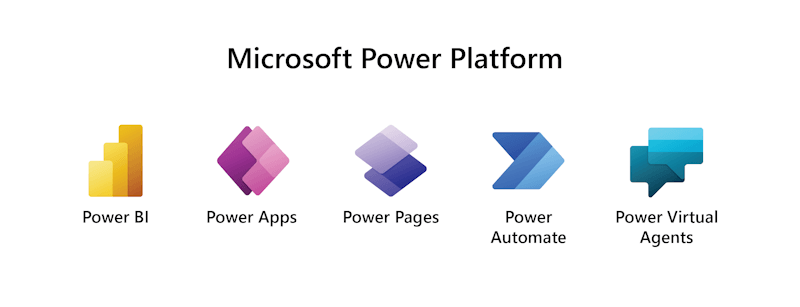 What if every employee, no matter their technical expertise or job description, had the power to use software development to create their own solutions? Imagine the kind of collective creativity that could arise if any of your employees could be citizen developers.
What if every employee, no matter their technical expertise or job description, had the power to use software development to create their own solutions? Imagine the kind of collective creativity that could arise if any of your employees could be citizen developers.
That’s exactly the promise of citizen development through low-code/no-code solutions augmented by AI. Throughout our organization, we’re empowering all kinds of employees—not just developers—to create their own business solutions and services using our citizen development toolkit, the Microsoft Power Platform.
Low-code/no-code puts development tools in the hands of people who aren’t technical developers or don’t have well-resourced software engineering teams.
—Lianne Zelsman, product manager, Power Platform governance
At Microsoft Digital, the company’s IT organization, we’re enabling citizen development internally by encouraging and enabling our employees to become citizen developers while also making sure we put guardrails in place to protect the company.
[Unpack how a revamped Microsoft business intelligence platform boosts data handling and builds trust. Discover powering decision making at Microsoft by analyzing data with Microsoft Power BI. Explore building a content management system at Microsoft with Microsoft Power Platform.]
The promise of citizen development
There are plenty of circumstances when someone needs a process, tool, or service to support their work but can’t access the formal engineering resources to create it. In those cases, it makes sense for our employees to build something for themselves. Historically, software developers or engineers would code their own solutions, while people without those skills were out of luck.
“Low-code/no-code puts development tools in the hands of people who aren’t technical developers or don’t have well-resourced software engineering teams,” says Lianne Zelsman, product manager in charge of Power Platform governance within Microsoft Digital. “For us, this means enabling our people in HR, Finance, and other teams to build solutions with the Power Platform. They can use it to do a whole range of things—from implementing automations to building their own apps—with very little ramp-up time or expertise.”
If you work in a large organization, you know that much of any employee’s day gets eaten up by mundane or menial tasks. Those are just the kinds of things that simple hand-made automations or apps can handle.
“We’ve seen a lot of Power Platform usage for project management teams that need to streamline their workflows or email communications,” says Bert Byerly, solution manager for Power Platform and Microsoft Fabric. “Even our developers who write code as their regular job are now using our low-code/no-code platform to spin things up quickly, like automations and alerts.”

More about the Microsoft Power Platform
At Microsoft, we believe in empowering our teams with tools that make their lives easier and their work more innovative. The Microsoft Power Platform is our low-code/no-code development solution that helps everyday employees turn great ideas into impactful tools. And because the technical professionals within Microsoft Digital have put the platform through its paces internally as Customer Zero, we’ve been able to add all kinds of features and functionality that better serve our customers.
“Power Platform comes with around 1,100 out-of-the-box connectors,” says Zohar Raz, group product manager for Power Platform governance. “This gives you the ability to build custom connectors that you can use to link up with any data source on the planet.”
We’re infusing Microsoft 365 Copilot into the platform so you can use AI to convert your natural language queries into solutions.
—Zohar Raz, group product manager, Power Platform governance
It also gives you access to a business layer called Dataverse that makes it easy for you to create and run thousands of solutions on top of your data layer.
And we’re also adding AI into the mix.
“We’re infusing Microsoft 365 Copilot into the platform so you can use AI to convert your natural language queries into solutions,” Raz says.
Giving your employees all this new richness and power is great, but we also recognize that you’ll want to govern and guide this usage. In response, we’ve made a lot of investments to give customers that kind of flexibility.
“The product gives organizations a lot of visibility and control and empowers them to determine which connectors and functionality to enable where,” Raz says.
As part of our overall technology stack, Power Platform plays very well with other Microsoft tools and platforms. That means organizations that use the Microsoft ecosystem benefit even more.
“For me, the greatest value comes from integration because Microsoft has such a wide-ranging product suite,” Zelsman says. “Building Power BI reports off of Power Platform assets, pulling SharePoint information into your Outlook, or automating reminders in Teams is really simple.”
Understanding the risks of low-code/no-code development
Along with the benefits, opening the development process to non-technical professionals presents certain risks.
“Enablement can be a double-edged sword,” says David Johnson, tenant and compliance architect with Microsoft Digital. “You’re empowering employees to be successful, but at the same time, you’re effectively creating applications that get used for business purposes without IT oversight, without security oversight, without privacy oversight—just an employee putting something together on their own.”
In deeply connected environments that have the power to extend company data outwards, that can be a dangerous situation if we don’t properly control it.
“The risk is mostly around data leaks,” Raz says. “This kind of technology works really well for good actors, but it also opens up opportunities for bad actors to find nuggets they can use to hurt the company.”
Addressing the risks through technology and governance policy
Two factors help us limit the risks associated with citizen development at Microsoft: the technology of Power Platform itself and the governance efforts of our Microsoft Digital team.
As a well-integrated piece of Microsoft technology, Power Platform gives IT a lot of control at the platform level to govern what people do in their individual apps.
—David Johnson, tenant and compliance architect, Microsoft Digital
“What Power Platform has done well for us is give us the control to lock things down tight,” Byerly says. “And then, as we look at different features or connectors and their interactions, we can start to loosen things up and create policies so they’re safe to use.”
That control is part of the core functionality of Power Platform.
”As a well-integrated piece of Microsoft technology, Power Platform gives IT a lot of control at the platform level to govern what people do in their individual apps,” Johnson says.
As a result, Power Platform enables a robust compliance strategy. Building and deploying that strategy has been a collaborative effort between Microsoft Digital’s governance professionals, the Power Platform product team, and the Microsoft Data-Loss Prevention team.
Our overall governance strategy breaks down into three sets of activities: Protect, measure, and enforce. Within this strategy, we divide our efforts between the macro-level, which sets policies for the overall tenant, and the micro-level, where individual groups within Microsoft can apply governance policies that complement our all-up guardrails.

“We’re forever finding the right balance between empowerment and safety,” Zelsman says. “So a lot of what we do is risk-based, essentially giving everything an internal risk rating, and that’s going to generate the scope of the compliance requirements any employee-developed solution will have to go through.”
That means we have to break our governance efforts down into tiers where we apply policies to employee-created solutions based on their risk profile and then channel them through permission reviews. For example, simple connectors associated with Microsoft Teams or SharePoint that operate in the Microsoft Personal Productivity environment need no permissions before pushing to production. On the other hand, a Dataverse connector built in the Microsoft Pro Dev environment requires an employee to request permission to access that environment or to change their environment before going live.
And of course, you can’t govern what you can’t see, so our teams have set up a thorough oversight apparatus to support these efforts. There’s a comprehensive tenant inventory, a reporting suite, cost and utilization monitoring, and compliance telemetry.
All of these governance policies aren’t meant to hinder citizen development, but help it move forward safely and quickly.
“Ultimately, good governance is employee empowerment with guardrails,” Johnson says.
Power Platform success stories

Thanks to our enablement and governance activities, low-code/no-code development is spreading rapidly across Microsoft. Recently, we crossed the threshold of 1 million Power Platform citizen development assets within the internal ecosystem at Microsoft—and that number continues to rise. All told, our employees have built more than 18,000 environments, 170,000 Power Apps, 50,000 Power Automate flows, and 1,200 chatbots.
But the numbers aren’t the whole story. The variety and creativity our employees have developed continues to increase.
We’re definitely looking to push this technology further. There are so many different data sources for us to analyze and so many workflows we can support.
—Bert Byerly, solution manager, Power Platform and Microsoft Fabric
Here are a couple of examples of important experiences our citizen developers have built internally at Microsoft:
- Cosmic: A revenue processing tool featuring data capture via optical character recognition (OCR), data validation through a business rules engine, and data entry using robotic process automation (RPA) that has yielded around $14.2 million annually in savings.
- AV design standards: A Real Estate and Facilities team app that helps configure AV equipment across 16,000 Microsoft conference rooms worldwide by simplifying the equipment ordering process.
And we’re only just beginning this journey. With so many connectors and the portfolio expanding every day, the possibilities are endless.
”We’re definitely looking to push this technology further,” Byerly says. “There are so many different data sources for us to analyze and so many workflows we can support.”
As this journey unfolds, we’ll continue to see Microsoft employees flexing their creativity and innovation through accessible citizen development with Power Platform.

Here are some tips for getting started with citizen development and the Power Platform at your company:
- Start with simple wins like automating approval flows to build up your users’ confidence.
- Establish some very secure baseline defaults to act as controls, then expand from there.
- Understand that your lines of business will adopt this technology on their own, so it’s best to guide their adoption through guided enablement.
- Take advantage of training material from Microsoft, especially the Microsoft Power Platform Center of Excellence Starter Kit.
- Put thought into your environment and tenant architecture, key personas, and scenarios before adoption.
- Identify the security needs and regulatory compliance that are specific to your organization and use built-in governance controls available for Dataverse for Teams and Personal Developer environments.
- Don’t reinvent the wheel: Use the open APIs and connectors that Microsoft already offers.
Try the Microsoft Power Platform at your company.

- Unpack how a revamped Microsoft business intelligence platform boosts data handling and builds trust.
- Discover powering decision making at Microsoft by analyzing data with Microsoft Power BI.
- Explore building a content management system at Microsoft with Microsoft Power Platform.

Want more information? Email us and include a link to this story and we’ll get back to you.





